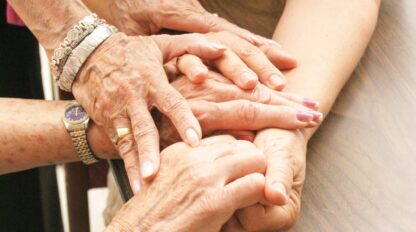Fostering intergenerational connections is key to the work that we do at Commonpoint Queens. This has never been more important than during the COVID-19 pandemic, when people are feeling isolated and we are pivoting to the virtual space to find community. In the second interview of our Intergenerational Connections series, we were able to connect Evan Rothstein and Michael and Galina Galmer.
Evan’s Story:
I was born in Russia in 2003, and adopted by a Jewish-American family in 2006. I converted to Judaism, however I did not identify much with my Jewish peers at a young age. I began to seriously explore Judaism when I attended a Jewish summer camp and bonded with Israeli and other Jewish teens. Soon after, I started teaching myself basic Hebrew and began to seek opportunities to actively participate in the Jewish community. Interviewing Russian Jewish members of Commonpoint Queens like Michael and Galina Galmer was a natural next step in my discovery process.
The Galmers’ Story As Told by Evan:
Michael and Galina Galmer are Russian immigrants who came to America to escape the highly oppressive and anti-semitic regime which defined the USSR’s communism. Growing up under the communist government for Michael made him appreciate the freedoms granted in America. Regarding the quality of life in Russia, he said “the only equality in Russia is that everyone is equally oppressed”. In Russia, he had a passion for art, but was unable to pursue it as a career because the government would not allow him to do so. He expressed great dissatisfaction with the policy that all workers were paid the same, and made it apparent that he was generally not happy about his inability to pursue the career he wished. He also made it clear that anti-semitism was prevalent in Russia, stating that in Russia, he was “unable to break the glass ceiling for Jews”, and warned that those who claim that socialism and communism bring social equality could not be any more wrong. Following the upheaval of the 70’s, which the Russian government largely blamed on Jews, he, his wife, and his young child, were offered the ability to move to America. He made it crystal clear, that even when he was deep in the depths of poverty in America, he never once even considered going back. He said “No one goes to Russia to live forever, but people come to America. Never the other way around.”. He told me that never has he heard of a case of a Russian immigrant coming to America and wanting to go back. Upon coming to America, Galina provided for the family while Michael started experimenting with silver art. Galina took the opportunity to take courses in English and computer science while Michael tried his best to get his work noticed. He started producing work in his garage up until a year, when they had a breakthrough, when Tiffany noticed his work and offered him employment opportunities. From there, he was able to build his brand and perfect his craft, becoming one of the most successful silver artists in the world, creating many well-known pieces and many successful exhibitions. Every year horse owners who win the Preakness race get a one-third scale replica of the Woodlawn Vase Preakness Trophy, which is made by Michael annually. Among other of his most well-known pieces are “Lust for Life,” “10 Commandments,” “Body from Egg,” and “Chrysanthemum Lady,” and many of his pieces have been exhibited at highly prestigious museums, such as, the Renwick Gallery of the Smithsonian American Art Museum, the Johns Hopkins University’s Evergreen Museum and Library, and the Holocaust Memorial and Tolerance Center in New York. His work has also been exhibited at the Cooper Hewitt of the Smithsonian Museum of Design, the Newark Museum of Art in New Jersey, the Long Island Art Museum at Stony Brook, and the Biggs Museum of Art in Delaware. Galina is also a successful artist, but unlike Michael, she paints and uses it to depict her emotions, which she has said helps her get over her shyness.
Judaism and antisemitism played a large role in their decision to come to America. Michael described the antisemitism in Russia compared to America as night and day. According to him, Russia blamed every major problem in their society on the Jews. The Refusenik movement of the 1970’s was completely blamed on the Jewish community, and they wanted them out so much that they even urged them to leave, offering to let them move to Israel or America. America, Michael said, is much different from Russia in terms of antisemitism. While Michael says it exists here, for him it has only existed on the micro scale. Antisemitic acts in America are not perpetrated by the government, rather, they are occasional instances which happen during personal interactions. Michael says that the way America treats minorities isn’t perfect, but it is infinitely better than the way minorities are treated in any European country. He is very grateful for the freedoms that he has been granted here which he likely would not have been granted elsewhere in the world. Judaism plays a very central theme in some of his works. One of his most important being “Tears of the Holocaust”, which takes a unique approach to representing the Holocaust, depicting the strength of the Jews rather than being a depiction of pain.
Commonpoint has been an important institution for the Galmer family. Taking an interest in Galina’s paintings, Commonpoint offered her the ability to exhibit her work, and since then, she has donated three paintings to Commonpoint. She also volunteers there to help translate English letters to Russian, distributing face masks to hospitals, and assisting in food delivery for seniors. In summary, the Galmers have contributed much to America and are thrilled to have lived their version of the American dream.



